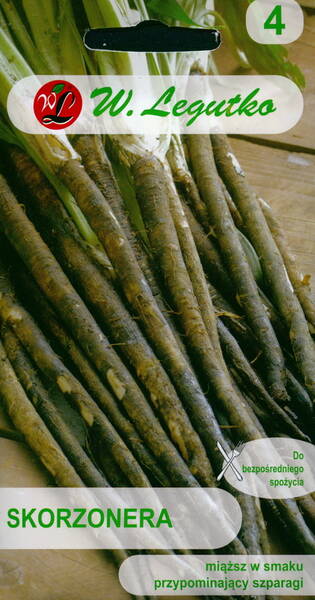A valuable dietary product with a high content of vitamins and mineral salts.
Scorzonera is cold hardy and relatively drought tolerant. Forms a rosette of oblong-ovate leaves, 2-4 cm in diameter and a long cylindrical black root.
Seeds are sown directly into the ground, seedlings are thinned out. 1.0 g = 90-100 seeds.
Ripening terms: technical ripeness occurs 100-120 days after sowing.
Usage: for fresh and dried consumption.
The root crop is cylindrical, 25-35 cm long, 2-4 cm in diameter, with a black or dark brown surface and white dense pulp.
The pulp is white, dense, secretes milky juice on the cut, sweet. It has the ability to regulate metabolism, it is useful in diabetes mellitus (it surpasses all other vegetables in this). Used fresh, dried and boiled. Young leaves can be used to make a salad.
Sowing of seeds is carried out in April or at the end of July-beginning of August to a depth of 2-3 cm. You can also do winter sowing in October. Shoots appear in 10-12 days.
Scorzoner or black root, sometimes also called black carrot.
* The plant is biennial: in the first year it forms a rosette of leaves and a long taproot (30–35 cm) of dark brown or black color. The roots overwinter well both in the ground and in storage. If the next year the root crop is not dug up, it will shoot an arrow, on which, after flowering, seeds will be tied. Root crops that have overwintered in the ground grow earlier and produce more seeds.
Scorzonera blooms for a long time (July - August).
Black salsify is sown in spring or late summer. Sowing is carried out either in two rows with a row spacing of 25–30 cm, and between rows of 60 cm, or in one row with a row spacing of 45 cm. In a row, after thinning, the plants are left 5 cm apart. Seeding depth 2.5-3 cm. 1.0 g = 400-600 seeds.
From experience, many gardeners were convinced that in order to get large root crops in the first year, it is necessary to sow in early spring. When sown in summer, the roots are small. However, they overwinter well and reach the greatest mass next year. Root crops are harvested before frost, while digging them carefully, without injuring them. Stored in wet sand. Cultivate black salsify on loose fertile soils. Seeds are sown in July-August or early spring. For sowing, deeply cultivated (up to 30-40 cm) soil is needed. Seeds are laid in grooves up to 3 centimeters deep at a distance of 12-15 centimeters from each other. Seedlings appear 12-18 days after sowing. Before sowing, do not forget to fertilize the soil with ammonium nitrate, potassium chloride.
Scorzonera loves soil rich in organic matter and having a deep arable layer.
The best predecessors are cucumbers, tomatoes, potatoes and onions. Fresh organic fertilizers are not applied for this vegetable plant.
Care consists in loosening the soil, removing weeds and watering.
There are few varieties of scorzonera (only about two dozen). The most interesting varieties produce roots weighing 60–70 g each. Their length is 16–18 cm, the diameter is 2–2.4 cm. The color is black in all, the flesh is white.
Black salsify roots contain up to 28.5% dry matter, ascorbic acid - from 3.4 to 9.2 mg/100 g.
Black salsifystewed in oil resembles asparagus, so it may well replace this gourmet curiosity.
Root vegetables boiled in salt water and fried in butter are a pleasant seasoning for second courses. Dried scorzonera will enrich the soup mixture. A delicious salad is prepared from young bleached leaves.
The healing properties of the plant are due to the presence of inulin, asparagine and levulin in the scorzonera - substances useful for the body. Harvest can come from autumn (from open ground), and from winter to spring - from storage.
Eng.: Black salsify. Bot.syn.: Scorzonera crispatula Boiss.











